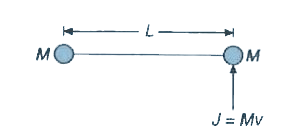Show that J=mΔV, where J is the impulse acting on a body of mass ma nd ΔV is the change in velocity.Solution in Assamese
Step by step video & image solution for Show that J = mDeltaV, where J is the impulse acting on a body of mass ma nd DeltaV is the change in velocity. by Physics experts to help you in doubts & scoring excellent marks in Class 11 exams.
Updated on:21/07/2023Topper's Solved these Questions
Similar Questions
What is Boltzmann's Law of equipartition of energy?Obtain it.
View SolutionThe surface tension of a liquid decreases with temperature. True or False?
View SolutionA force exerts an impulse J on a body changing its speed from u to υ. The force and object's motion are along the same line. Show that the work done by the force is J(u+υ)/2
View SolutionComprehension # 2
When two bodies collide normally they exert equal and opposite impulses on each other. Impulse = change in linear momentum. Coefficient of restitution between two bodies is given by :-
e=|Relative velocity of separation||Relative velocity of approach|=1, for elastic collision

Two bodies collide as shown in figure. During collision they exert impulse of magnitude J on each other.
For what value of J (in N−s ) the 2kg block will change its direction of velocity :-
View Solutionआवेग से आप क्या समझते है? दिखाइये की किसी पिण्ड पर कार्यरत आवेग उस पिण्ड के रेखीय संवेग में परिवर्तन के बराबर होता है।
View SolutionThe total energy of a body executing a linear S.H.M. is 20 J. What is the maximum velocity of the body, if the mass of the body is 0.4 kg ?
View Solutionद्रव्यमान M दो गेंदें एक हल्के दृढ़ दण्ड द्वारा चित्रानुसार जुड़ी हैं। यदि निकाय के एक द्रव्यमान को आवेग J=Mv दिया जाए तो उसका कोणीय वेग होगा

View SolutionA force of 5 N acts on a body for 2 milliseconds. Calculate the impulse. If the mass of the body is 5 g, calculate the change of velocity.
View SolutionA force of 5 N acts on a body for 2 milliseconds. Calculate the impulse. If the mass of the body is 5 g, calculate the change of velocity.
View SolutionThe force acting on a body of mass 10 kg is (2ˆi+j−ˆk) N. If the body is initially at rest, then velocity at the end of 20 sec will be
View SolutionA force of 20 N acts on a body for 2 micro second. Calculate the impulse. If the mass of the body is 1 g, calculate the change of velocity.
View SolutionA large force is acting on a body for a short time. The impulse imparted is equal to the change in
View SolutionA large force is acting on a body for a short time. The impulse imparted is equal to the change in
View SolutionA force of 5 N acts on a body for 2 milliseconds. Calculate the impulse. If the mass of the body is 5g, calculate the change of velocity.
View SolutionA large force is acting on a body for a short time. The impulse imparted is equal to the change in
View Solution
